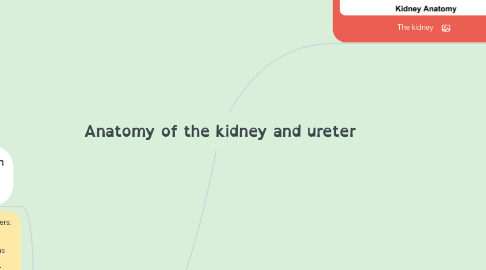
1. Ureter
1.1. Ureters are fibromuscular tubes lined with epithelium, which carry urine to the storage tank, the urinary tract.
1.2. The walls of the ureters have three layers: 1.- The internal mucosa: which is transitional epithelial tissue, continuous with that of the pelvis of the kidney superiorly and with that of the bladder medially. 2.- The muscular layer: it is the middle layer, and it is mainly made up of two sheets of smooth muscles: an internal one whose fibers run longitudinally to the ureter, and an external one that circularly covers the duct. In the last lower third, an additional external layer of longitudinal smooth musculature appears. 3.- The adventitia: that covers the external surface is typically fibrous connective tissue.
1.3. Urine does not reach the bladder by gravity alone, and the ureters play an important role in driving it. Stretching of the ureter due to the entrance of urine stimulates your muscles to contract, thus propelling the fluid into the bladder. The strength and rate of peristaltic contractions adjust to the rate of urine production. Contraction control is mainly carried out in response to local stimulation, and although the ureter is innervated by sympathetic and parasympathetic fibers, its significance appears to be minimal compared to local influence.
2. The kidney
2.1. Its a retroperitoneal organ, each adult 12 cm in length 6 cm in width 3 cm anteroposterior dimension.
2.2. The medulla and cortex are made up of nephrons and collecting ducts. The cortex is slightly darker than the medulla and contains renal corpuscles and outlined rubules. The medulla contains collecting tubes, these converge to the renal pyramids and open to the lesser pelvis.
2.3. The renal pelvis and its calyces are found in the renal sinus. The breast is a cavity that extends into the hilum. In the hilum the renal pelvis is transformed into the ureter.
2.4. The kidney is encapsulated by a thin layer of dense fibrous tissue.
2.5. The nephron
2.5.1. the functional unit of the kidney is the nephron, there are around a million for each of the kidneys, each nephron together with a collecting tube form a urinary tube, fill the medulla and the cortex of the kidney.
2.5.2. The nephron is the one that filters the blood in the kidney and converts waste from the blood into urine.
2.6. The blood supply of the kidney
2.6.1. The kidneys receive more than 1 litreof blood per minute, amounting to more than 20% of the total cardiac aotput
2.6.2. the renal artery is divided into 5 arteries, each one supplies a renal segment, within the renal sinus the vessels divide into interlobal arteries, passing between pyramids.
2.6.3. Glomerulus blood through the afferent arteriole
2.6.4. the draining veins join the interlobular veins and the venous blood continues to the hilum

